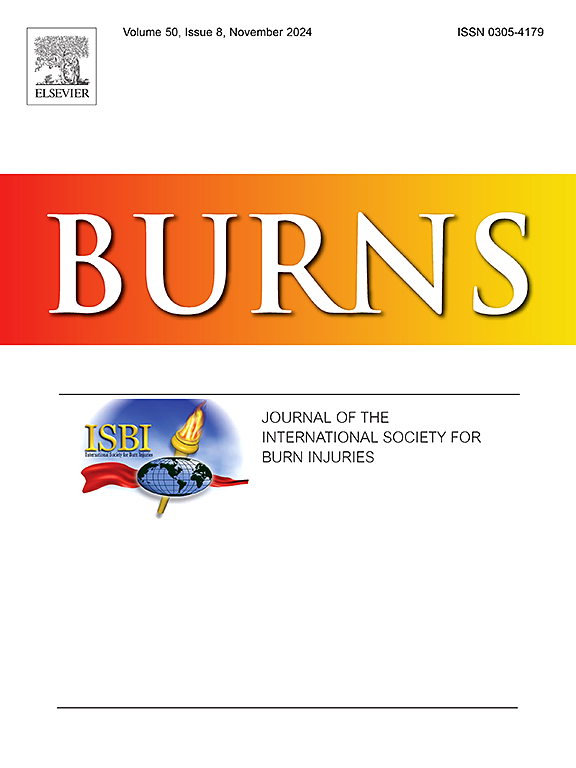Feasibility of collecting long-term patient-reported outcome data in burns patients using a centralised approach
IF 3.2
3区 医学
Q2 CRITICAL CARE MEDICINE
引用次数: 0
Abstract
Background
Collecting patient-reported outcome measures (PROMs) has been a longstanding priority for the Burns Registry of Australia and New Zealand (BRANZ). An earlier pilot of hospital-led PROM collection encountered low participation rates and high loss to follow-up, indicating consideration for an alternative model was warranted.
Aims
To establish the feasibility of implementing centralised long-term PROM collection within the BRANZ.
Methods
Two burn services participated in this prospective, longitudinal pilot. PROMs were collected from patients admitted to the services between January and December 2021 who survived to discharge. Follow-up occurred via telephone or online self-completion at three, six, and 12 months post-injury using burn-specific and generic health-related quality-of-life measures.
Results
There were 450 patients (423 adult patients [≥ 16 years] and 27 paediatric patients [< 16 years]) who could be contacted and agreed to participate in the follow-ups. Most patients initially opted for telephone rather than online self-completion (n = 305, 67.5 %). No key sociodemographic or injury event factors were associated with specifically opting for online self-completion. The follow-up rates were 81.1 % at three months, 81.9 % at six months, and 77.3 % at 12 months. Data missingness was low (i.e., < 2 %) for all instrument items, excluding the visual analogue scale scores of the 5-Level EuroQoL 5 Dimensions Questionnaire and the two paediatric burn-specific measures.
Conclusions
Collecting PROMs from burns patients in the first 12 months after injury via a centralised approach was shown to be feasible, with higher participation rates and low missingness.
采用集中方法收集烧伤患者长期疗效数据的可行性。
背景:收集患者报告的结果指标(PROMs)一直是澳大利亚和新西兰烧伤登记处(BRANZ)的优先事项。早些时候,由医院主导的PROM收集试点工作遇到了参与率低和随访丢失率高的问题,这表明有必要考虑采用其他模式。目的:确定在BRANZ内实施集中式长期PROM收集的可行性:方法:两家烧伤医疗机构参与了这项前瞻性纵向试点项目。从 2021 年 1 月至 12 月期间入院并存活至出院的患者中收集 PROM。在伤后3、6和12个月时,通过电话或在线自我填写的方式,使用烧伤特异性和通用的健康相关生活质量测量方法进行随访:共有 450 名患者(423 名成年患者[≥ 16 岁]和 27 名儿童患者[< 16 岁])可以联系到并同意参加随访。大多数患者最初选择电话而非在线自我填写(n = 305,67.5%)。没有关键的社会人口学或受伤事件因素与特别选择在线自我填写有关。三个月、六个月和 12 个月的随访率分别为 81.1%、81.9% 和 77.3%。所有工具项目的数据缺失率都很低(即小于 2%),但不包括欧洲生活质量 5 维度问卷的 5 级视觉模拟量表评分和两个儿科烧伤专用测量项目:通过集中方法收集烧伤患者伤后头12个月的PROMs是可行的,参与率较高,缺失率较低。
本文章由计算机程序翻译,如有差异,请以英文原文为准。
求助全文
约1分钟内获得全文
求助全文
来源期刊

Burns
医学-皮肤病学
CiteScore
4.50
自引率
18.50%
发文量
304
审稿时长
72 days
期刊介绍:
Burns aims to foster the exchange of information among all engaged in preventing and treating the effects of burns. The journal focuses on clinical, scientific and social aspects of these injuries and covers the prevention of the injury, the epidemiology of such injuries and all aspects of treatment including development of new techniques and technologies and verification of existing ones. Regular features include clinical and scientific papers, state of the art reviews and descriptions of burn-care in practice.
Topics covered by Burns include: the effects of smoke on man and animals, their tissues and cells; the responses to and treatment of patients and animals with chemical injuries to the skin; the biological and clinical effects of cold injuries; surgical techniques which are, or may be relevant to the treatment of burned patients during the acute or reconstructive phase following injury; well controlled laboratory studies of the effectiveness of anti-microbial agents on infection and new materials on scarring and healing; inflammatory responses to injury, effectiveness of related agents and other compounds used to modify the physiological and cellular responses to the injury; experimental studies of burns and the outcome of burn wound healing; regenerative medicine concerning the skin.
 求助内容:
求助内容: 应助结果提醒方式:
应助结果提醒方式:


